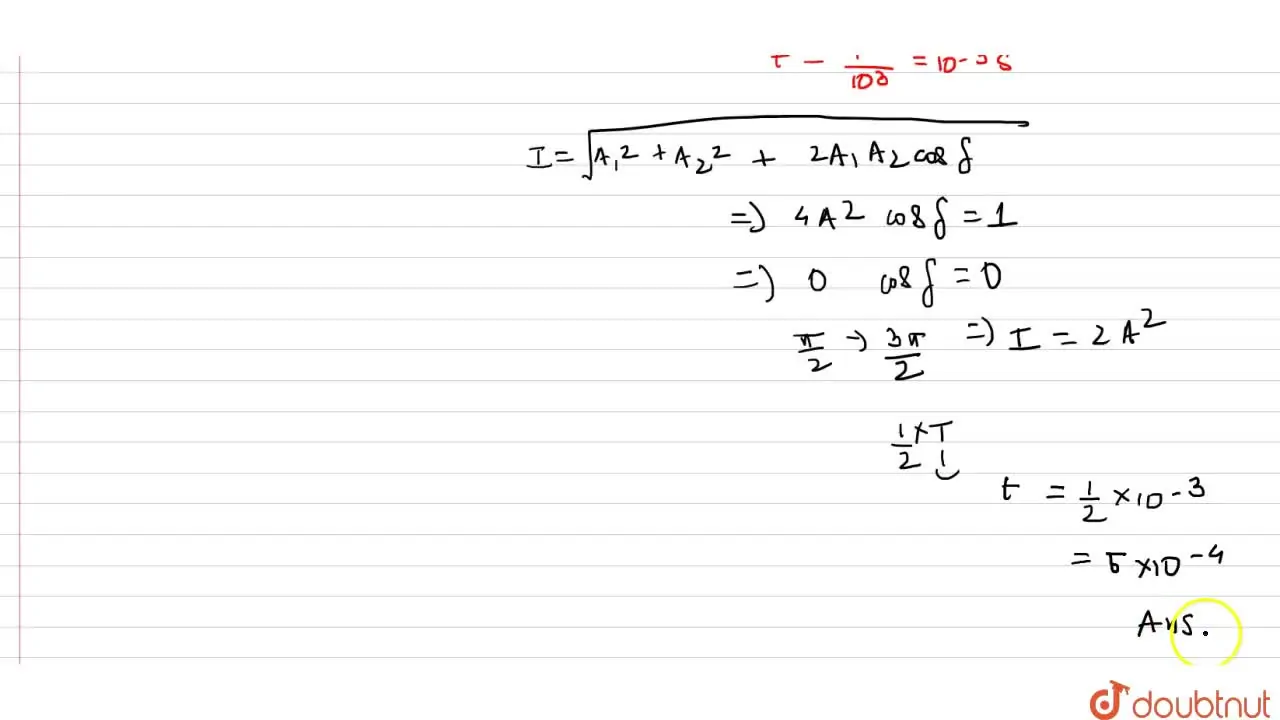Two radio stations broadcast their programmes at the same amplitude A, and at slightly different frequencies ω1andω2 respectively , where ω2−ω1=103Hz. A detector receives the signals from the two stations simultaneously . It can emit signals only of intensity ≥2A2.
(i). Find the time intervals between successive maxima of the intensity of the signal received by the detector .
ii. Find the time for which the detector remains idle in each cycle of the intensity of the signal .
i. Let the signal waves be given by
y1Asin2πω1t,y2=Asin2πω2t.
The resultant disturbance is given by
y=y1+y2=Asin2πω1t+Asin2πω2t
=2Asin(2π(ω1+ω2)t)2cos(2π(ω2−ω1)t)2
=2Acosπ(ω2−ω1)tsin2π(ω1+ω2)t2
Let ω1=ω,ω2=ω+Δω
Therefore , ω1+ω2≈2ω
y=2Acosπ(ω2−ω1)tsin2πωt
Thus , the resultant disturbance has amlitude 2Acos(ω2−ω1)t
For maxima : cosπ(ω2−ω1)t=±1
or π(ω2−ω1)t=rπ,r=0,1,2,3
t=rω2−ω1=0,1ω2−ω1,2ω2−ω1,...
Clearly time interval between successive maxima
=1ω2−ω1=1103=10−3s
ii. The resultant intensity is given by
I=A21+A22+2A1A2cosδ
when δ=0 , intensity is maximum Imax=4A2
When Δ=π/2,intensityI=2A2
When Δ=π,intensityImin=0
When Δ=3π/2,intensityI=2A2
When Δ=2π,intensityImax=4A2
The detector remaining idle from θ=π/2→3π/2 or in each half cycle . Hence the required time
t=T2=10−32=5×10−4s
Similar Questions
Two radio stations broadcast their programmes at the same amplitude A and at slightly different frequencies ω1 and ω2 respectively, where ω1−ω2=103Hz. A detector receives the signals from the two stations simultaneously, it can only detect signals of intensity ≥2A2.
(i) Find the time interval between successive maxima of the intensity of the signal received by the detector.
(ii) Find the time for which the detector remains idle in each cycle of the intensity of the signal.View SolutionWhen two waves of almost equal frequencies n1 andn2 reach at a point simultaneously, what is the time interval between successive maxima ?
View SolutionFind the amplitude of the electric field in a parallel bean of light of intensity 2.0Wm−2.
View SolutionWhen two waves of almost equal frequencies v1 and v2 reach at a point simultaneously, the time interval between successive maxima is
View SolutionThe planes sources of sound of frequency n1=400Hz,n2=401Hz of equal amplitude of a each, are sounded together. A detector receives waves from the two sources simultaneously. It can detect signals of amplitude with magnitude ≥ a only,
View SolutionTwo waves of frequency 500 Hz and 498 Hz are produced simultaneously. Calculate the time interval between successive maxima.
View SolutionTwo waves of frequencies 50 Hz and 45 Hz are produced simultaneously, then the time interval between successive maxima of the resulting wave is [maxima refers to the maximum intensity]
View SolutionTwo lenses have focal lengths f1 and f2 and their dispersive powers are ω1 and ω2 respectively. They will together form an achromatic combination if
View SolutionTwo discs A and B are in contact and rotating with angular velocity with angular velocities ω1andω2 respectively as shown. If there is no slipping between the discs, then
 View Solution
View SolutionWhen two progressive waves of intensity I1 and I2 but slightly different frequencies superpose, the resultant intensity flutuates between :-
View Solution


